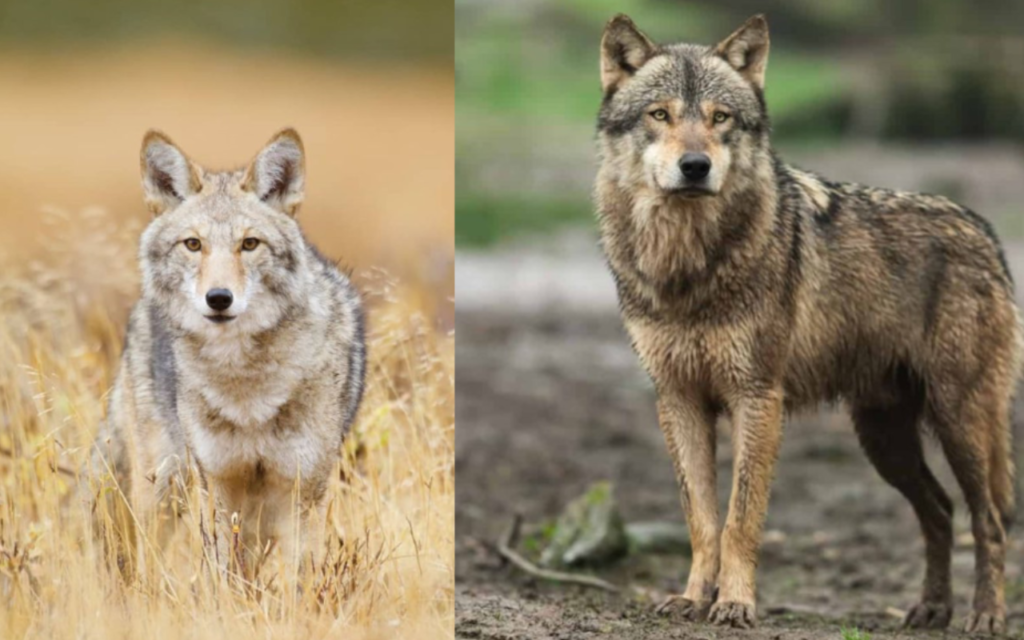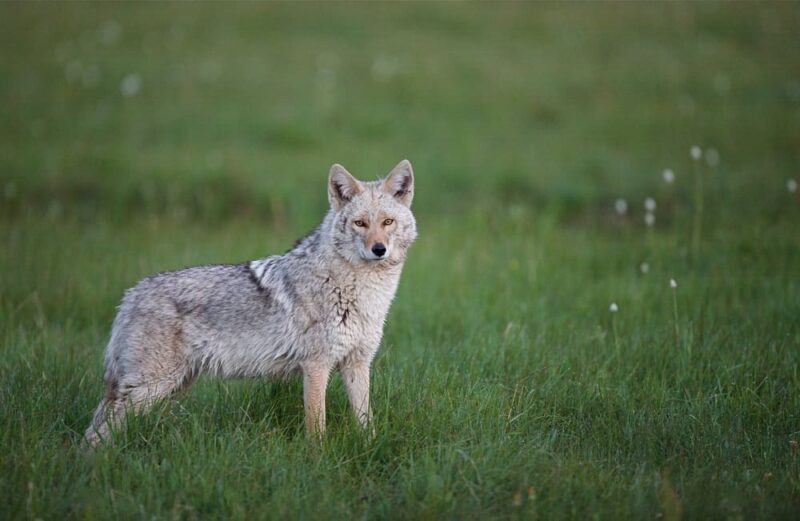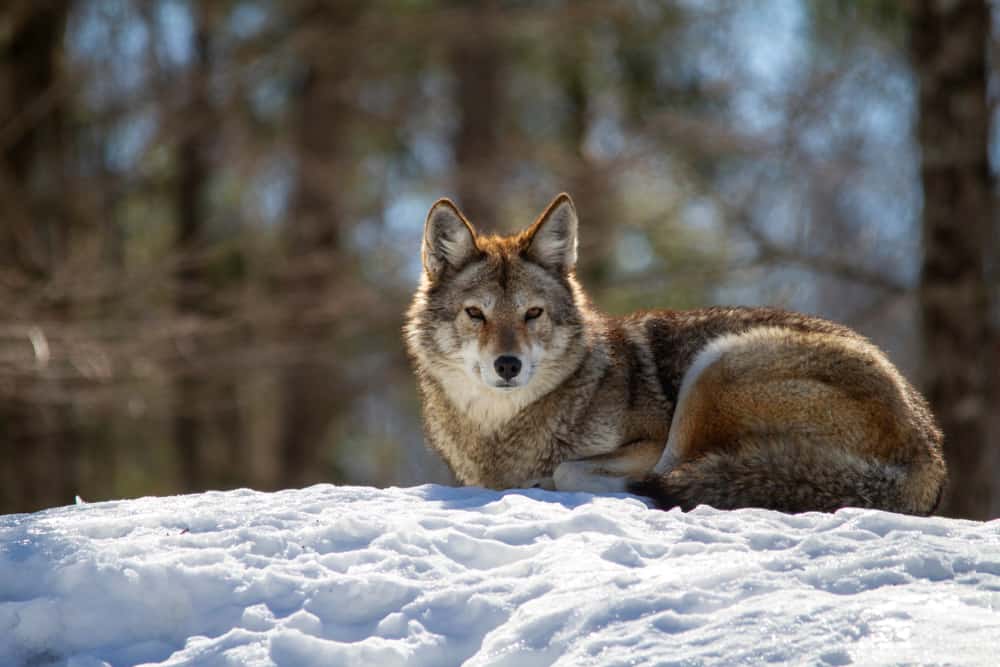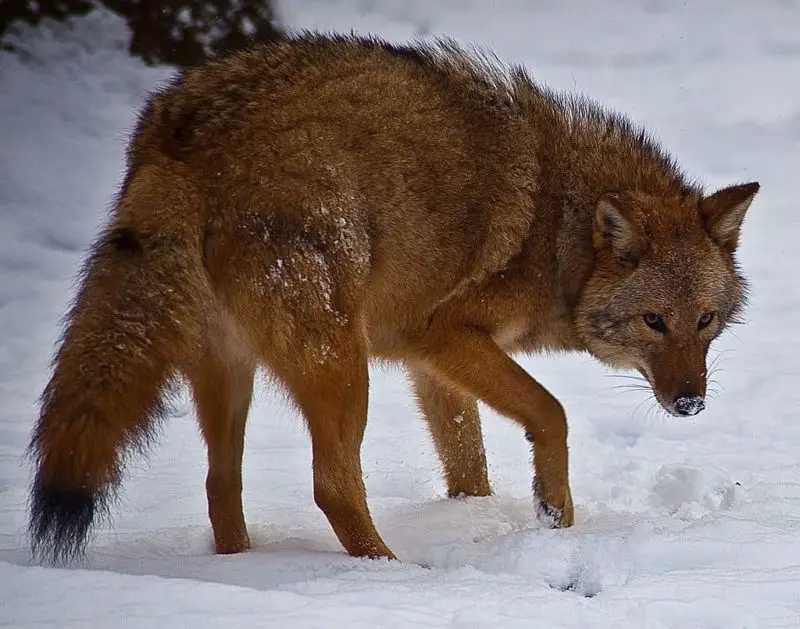Wolves, which were once hunted to near-extinction in the contiguous United States, have begun making a comeback. Coyotes have been extending their range across the country, too, moving out of their traditional western haunts and into the east. During the course of all of this ecological disturbance, a new hybrid, some say species called the coywolf, has emerged. Coywolves are coyote/wolf hybrids. More specifically, they are hybrids between eastern wolves and western coyotes. So, yes, wolves and coyotes do mate. At least, they do under certain circumstances.
Coywolf Basics
The scientific name for the coywolf is (Canis latrans var). The colloquial name for coywolves is eastern coyotes, which doesn’t really help make what animal people are talking about very clear. However, for a long time, people thought that the coywolves they saw in the wild were just an eastern breed of coyote, so the name is understandable.
Coywolves are somewhat smaller than normal wolves and larger than normal coyotes and look very much like both species. Which makes sense as, other than size, both wolves and coyotes look a lot like each other.

How Are Wolves and Coyotes Different?
Wolves are very social creatures. They live in packs all year round.
On the other hand, coyotes spend time in a family group when they are raising their pups. However, they spend most of their time alone. Another exception is during breeding season when they travel in pairs.
Wolves howl to communicate over long distances, and bark and growl to communicate face-to-face. Coyotes also howl to communicate over long distances. However, while they do bark and growl when face to face, their communication features a lot more yapping sounds.
Both wolves and coyotes hunt mice and other small mammals. Wolves, however, also hunt more large prey like deer. Coyotes hunt deer as well, but they are mostly confined to hunting young deer, and the circumstances have to be just right for them to make a kill.
How Closely Related Are Coyotes and Wolves?
The biological definition of a species is the largest group of organisms in which two individuals of the appropriate gender can mate and produce fertile or, in other words, reproductively viable offspring. However, there is some gray area in this definition.
Some closely related species can produce offspring, such as lions and tigers or donkeys and horses. The offspring of lions and tigers are called ligers. Ligers are reproductively viable.
On the other hand, the offspring of horses and donkeys, which are called mules, have an odd number of chromosomes since they inherit 32 from their horse parent and 31 from their donkey parent. Therefore, they cannot reproduce in most instances.
Wolves and coyotes both have 78 chromosomes. Their offspring would inherit 39 chromosomes from each parent and are able to reproduce in subsequent matings.
There are two different species of wolf in America which are red wolves (or Canis rufus as they are known scientifically) and gray wolves (Canis lupus) or eastern wolves, (Canis lycaon). The scientific name for coyotes is (Canis latrans). They are all different species in the same genus. So, coyotes are about as closely related to either species of wolf as the two species of wolf are related to each other. It is not really so surprising that they could produce viable offspring.

How Common Are Coywolves?
Coywolves have proven to be a very successful hybrid. It is estimated that there are over a million of them spread in eastern North America. The range of the northeastern variety of coywolf begins in Virginia and go’s northward through the northeastern United States and into the Canadian provinces of Ontario, Quebec, New Brunswick, Nova Scotia, Prince Edward Island, Newfoundland, and Labrador.
There are also coywolves in the southeastern United States. Genetic surveys of wild coyotes in the southeast show that in some areas, 38 to 62% of the coyote genomes sampled contain red wolf genes. See
The success of coywolves may be due to their hybrid nature. For the most part, Wolves are leery of civilization. Coyotes also prefer open places but will even sometimes go into urban areas. Coywolves are comfortable everywhere, and will fill ecological niches in forests, plains, cities, or wherever they find themselves.
Their great intelligence has proven to be a distinct advantage in helping them fit into many different ecological niches. They are even smart enough to look both ways before crossing a road, so they’re fairly safe even in large cities. Wherever coywolves are found, they seem well-adjusted to their environments. See
How Did Coywolves Come to Be?
Although wolves and coyotes are capable of interbreeding, the success of the coywolf hybrid is somewhat surprising, because each species definitely prefers to mate with its own kind. While wolf/coyote hybrids could theoretically happen occasionally, it’s difficult to see how it could happen so often as to produce such a large population of hybrids. Scientists think that it’s likely the result of the near-extinction of eastern wolves.
Coywolves only started appearing over the last century, right after the depletion of the eastern wolf populations. This near-extinction shook up the ecosystem across North America. One result of this is the movement of coyote populations out of their traditional western home ranges and into regions they had not previously inhabited. So, in the early 20th century, they started spreading into the East.
There, they occasionally ran into isolated wolves. Some female coyotes mated with male wolves and vice versa around the Great Lakes in eastern Canada and bore hybrid young. This happened often enough that a large population of coywolves was created.
Scientists looking for evidence of past hybridization have used genetic testing to pinpoint when it started. This testing suggests that the first coyote and wolf mating happened about 100 years ago. From their initial Canadian habitat, early coywolves spread into New England, upstate New York, and points south. Today, they have even been seen in North Carolina and other southern states.
But Wait, There’s More
It turns out that there’s more to the coywolf than just a blend of coyote and wolf. Tests of coywolf DNA show that there are dog genes present in most coywolves as well. These same tests suggest that coyotes mated with dogs about 50 years ago and that these coydogs then interbred with coywolves.
Scientists estimate that genetically speaking, eastern coywolves are approximately 65% coyote, 25% wolf, and 10% dog. At least, that’s the typical mix in the northeastern United States. The mix varies more in different places in the deep south, with some southern coywolves having much more wolf in them, and others having lesser amounts of wolf and much more dog in them.
The presence of dog DNA may help explain why coywolves are so at home in city environments. Domestic dogs have been bred for generations to be able to tolerate the loud noises, confusion, and crowding of human cities. Wolves and coyotes are shyer of them. Their dog ancestors may have given their tolerance of urban environments to modern coywolves. In any event, coywolves have certainly started to become a staple in cities across the eastern U.S. and Canada, although they tend to avoid people.
Are Coywolves Actually A New Species?
Coywolves are certainly new animals, but are they actually a new species? Some scientists do believe that coywolves actually constitute a new, unique species. They point out that there are distinct genetic markers in coywolves, as is typical of any distinct species. This, they think, makes coywolves just as much a separate species as coyotes and wolves.
Other scientists claim that this genetic distinctiveness isn’t enough to classify coywolves as a distinct species all on its own. They point out that a traditional part of the scientific definition of a species is a population of creatures that is so genetically distinct from others that it cannot successfully interbreed with them. For example, Roland Kays, who is a research associate professor in the NC State Department of Forestry & Environmental Resources, states that “we should not call the genetic blending within the Canidae family the “coywolf” — doing so gives the impression that they are a new species. Using such an inaccurate name leads to confusion”. See
The first group tends to reply that wolves and coyotes are considered separate, unique species and that they interbred to create coywolves. The problem seems to come from the fact that scientists don’t really have a rigid, agreed-upon, definition of exactly what a species is.

What Does the Future Hold for Coywolves?
Coywolves are new, but it looks like they’re here to stay. They’re becoming very common in the East. If they can thrive in urban areas like New York City, they can thrive pretty much anywhere. They certainly do in the eastern U.S. and Canada.
They’re not common in the West if they exist there at all. However, that may change in the future. As their numbers in the east grow, it is not at all unlikely that they’ll start heading west, where their coyote ancestors came from.
As for what happens when they get there, who can tell? But it doesn’t seem unreasonable to think they might start breeding into the coyote population there or even out-competing them. Coyotes have been long established in their western ecological niches, but coywolves have all of their cleverness and adaptability while also being stronger. The coywolves’ longer legs let them run faster than coyotes, too. They can hunt large game animals that are often not options for the smaller coyote. They might very well out-compete purebred coyotes.
Indeed, it’s possible that they’ll even eventually replace wolves in much of North America. That’s because they’ve been breeding back into the eastern North American wolf populations. Genetic studies indicate that many, if not most, wolves in the northeast have some coyote genes in them. And that is complicating efforts to preserve the eastern wolf, or gray wolf, as its numbers are not so well improved that they’re not still in a precarious position. Western wolves are less prone to breeding with coyotes, but it’s not unheard of. They might be more prone to mating with coywolves, as coywolves are more wolf-like.
It could very well prove to be that, eventually, there are no more wolves or coyotes, just various subspecies of coywolves. They do seem to have hybrid vigor, and their adaptability to a wide range of environments means that natural selection may favor them, in the long run, over their purebred cousins.
Final Thoughts
Coywolves are a fascinating new breed of animal. They haven’t been studied by scientists very well yet, but their increasing numbers, a product of their cleverness and adaptability, are starting to draw a lot more scientific attention. There are probably a lot of interesting revelations to come about them in the future.
Also, see; Are There Coyotes in New York?
Recent Posts
The only venomous snakes in Washington State are Northern Pacific Rattlesnakes. The Northern Pacific Rattlesnake (Crotalus oreganus oreganus) is a sub-species of the Western Rattlesnake. Anyone...
Skunks are not classified as true hibernators. But they go into a state of torpor when the weather gets cold. Skunks are light sleep hibernators, along with opossums, bears, and raccoons. ...

